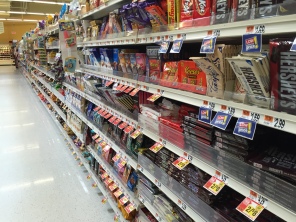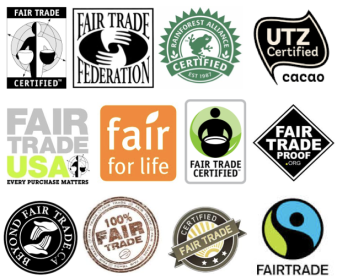In THE BITTER SIDE OF SWEET, Amadou, Seydou, and Khadija are forced to work as slaves on a cacao farm in the Ivory Coast. Sadly, this is reflective of the reality of how most mainstream chocolate in the world today is grown.
What can you do?
If you’re upset about the way that chocolate is produced, there are a variety of things you can do about it.
- You can stop using all chocolate forever. This is called a “boycott,” and maybe you feel that you can do this.
- You can find an alternative source of your favorite sweet treat, though this can be trickier than it seems… have a look at my “What about Fair Trade?” section below and check out SlaveFreeChocolate.com’s updated list of ethical chocolate companies:
https://www.slavefreechocolate.org/ethical-chocolate-companies  You can approach the companies that produce the chocolate you already like and work to convince them to be more careful about child labor in their supply chain. (Companies really do listen to kids! Take a look here to see how Harry Potter fans got all of Warner Brothers to change their chocolate purchasing.)
You can approach the companies that produce the chocolate you already like and work to convince them to be more careful about child labor in their supply chain. (Companies really do listen to kids! Take a look here to see how Harry Potter fans got all of Warner Brothers to change their chocolate purchasing.)- You can educate your friends, family, class, sports team, scout troop, etc. about the way chocolate is made. For example, before Halloween, you could do some “pre” trick-or-treating where, before your friends and neighbors have bought mainstream chocolate to give out, you go door to door and give them information about child slavery in those products and encourage them to purchase non-chocolate treats for the holiday.
- Come up with your own ideas of how to help! I decided to write a book to highlight what is going on, but each of us has something unique and creative we can do. If something occurs to you: do it! And, if you have the time, shoot me an email and let me know about it so I can share it with others on my website.
The more people who do something, the more the industry will change. The US has one of the highest levels of chocolate consumption, per person, in the world. If even a fraction of us begin to allow what we care about to influence our choices, we can have a big impact on global markets.
What about Fair Trade?
Organic and Fair Trade chocolate is almost always ethically sourced. Cocoa from outside West Africa is almost always ethically grown. Very often the label will spell that out and tell you the source.
The added emphasis in the above quote is mine, but I think this statement goes a long way to explaining the problem behind “better” chocolate (and many other consumer goods).
 There is a bewildering array of Fair Trade certification logos out there… and every one of them has a different set of criteria for a product to be able to display them. If you want to see what (or whether!) a product you like has a commitment you feel like supporting, you need to research the minimum standards for the logo they carry.
There is a bewildering array of Fair Trade certification logos out there… and every one of them has a different set of criteria for a product to be able to display them. If you want to see what (or whether!) a product you like has a commitment you feel like supporting, you need to research the minimum standards for the logo they carry.
“Fair Trade” generally means just one thing: that farmers were offered a reasonable minimum price for their product. Many certifications have additional sub-goals of being eco-friendly or promoting community projects, but this varies by company. Many brands “prohibit” slave or child labor… but how stringently are these guidelines are enforced? For example, how often are source farms visited by an third party? Are these visits announced ahead of time, or are they spot-checks? You may not be able to find the answers to all of these questions, but whatever information you can uncover will help you make a more educated choice.
According to Clay Gordon, creator of chocoholics’ website The Chocolate Life, and a recognized authority on everything from cacao taste to business practices, “sustainability has three pillars: environmental, economic, and social.” While the available labels can provide some indications about how a company scores on these metrics, no single one fully satisfies all three.
-Grist, A Guide To Ethical Chocolate, 2013
When you read through the mission statements of these companies, most deal in generalities. It is probably safe to say that most companies that carry a logo are “trying harder” than mainstream companies… but, by how much? For example, I found one chocolate brand that was proudly sporting a fair trade logo and was priced and placed in the “good” chocolate section of the supermarket, but upon researching their practices I found out that they only use 20% fair trade beans. Which means, of course, that 80% of their beans (the vast majority) came from sources they knew to be exploitative. And yet, there they were, marketing themselves as “better.” Sure enough, the minimum standard for the logo they were sporting was to contain “at least 20% Fair Trade ingredients.”
Another example is the current trend among mainstream chocolate manufactures to adopt these logos. Cadbury’s Dairy Milk bars (but only those bars) are now Fair Trade certified. Mars Bars (those sold in England and Ireland) and most recently, Hershey’s, are committing to source their chocolate through Fair Trade cocoa certifying organizations. To escape the heat on this issue, many mainstream companies are now agreeing to certify an item or two, or are agreeing to a slow plan of transition to “better” beans. Sometimes they develop or purchase a fair trade sub-brand. Green & Black, for example, is owned by Cadbury, which in turn is owned by Kraft. Are these steps victory… or do they raise suspicions as to what, exactly, these very calculating companies are committing themselves to? How stringent are the requirements if mainstream chocolate manufacturers are seamlessly adopting these logos for parts of their production chain? Logos can sometimes be misleading.
What you end up choosing to do about the chocolate you eat—what details of mission statement, what levels of scrutiny of policy, etc. go into your cocoa—is up to you. The Ethical Chocolate Companies List at SlaveFreeChocolate.com is a great place to start but, whatever you choose, thank you for taking the time to inform yourself about one of your favorite treats instead of enjoying it mindlessly. I hope that someday our world will no longer be one in which children on one side of the globe are forced to endure a terrible existence to ensure that children on the other side of the world have something sweet and cheap to snack on.
Resources
More about chocolate:
- Documentary: The Dark Side of Chocolate (https://www.youtube.com/watch?v=7Vfbv6hNeng)
- Blog: “The Chocolate Industry Exposed: Child Labor, Trafficking and Fair Trade Mislabeling” (https://listengirlfriends.wordpress.com/2013/03/15/1990/)
- How chocolate is made, overview: http://www.worldcocoafoundation.org/about-cocoa/cocoa-value-chain/
- “Fair Trade in The Classroom,” curriculum resources through Global Exchange (http://www.globalexchange.org/fairtrade/cocoa/classroom)
- Possible global chocolate shortage: (http://m.wamu.org/#/news/15/03/15/the_fate_of_the_worlds_chocolate_depends_on_this_spot_in_rural_england)
More about modern-day slavery:
- http://www.slavefreechocolate.org
- http://www.endslaverynow.org
- http://knowmore.org
- http://www.stopthetraffik.org/campaign/chocolate
- Article: How to Talk to Your Kids About Modern Day Slavery (http://simplehomeschool.net/modern-day-slavery/)
- PBS Newshour “You Probably Benefited From Slave Labor Today” (http://www.pbs.org/newshour/updates/slave-made-goods-now-available-freezer-section/)
- Interactive (but very long) tool to estimate your personal slavery footprint: (http://slaveryfootprint.org/survey/)
